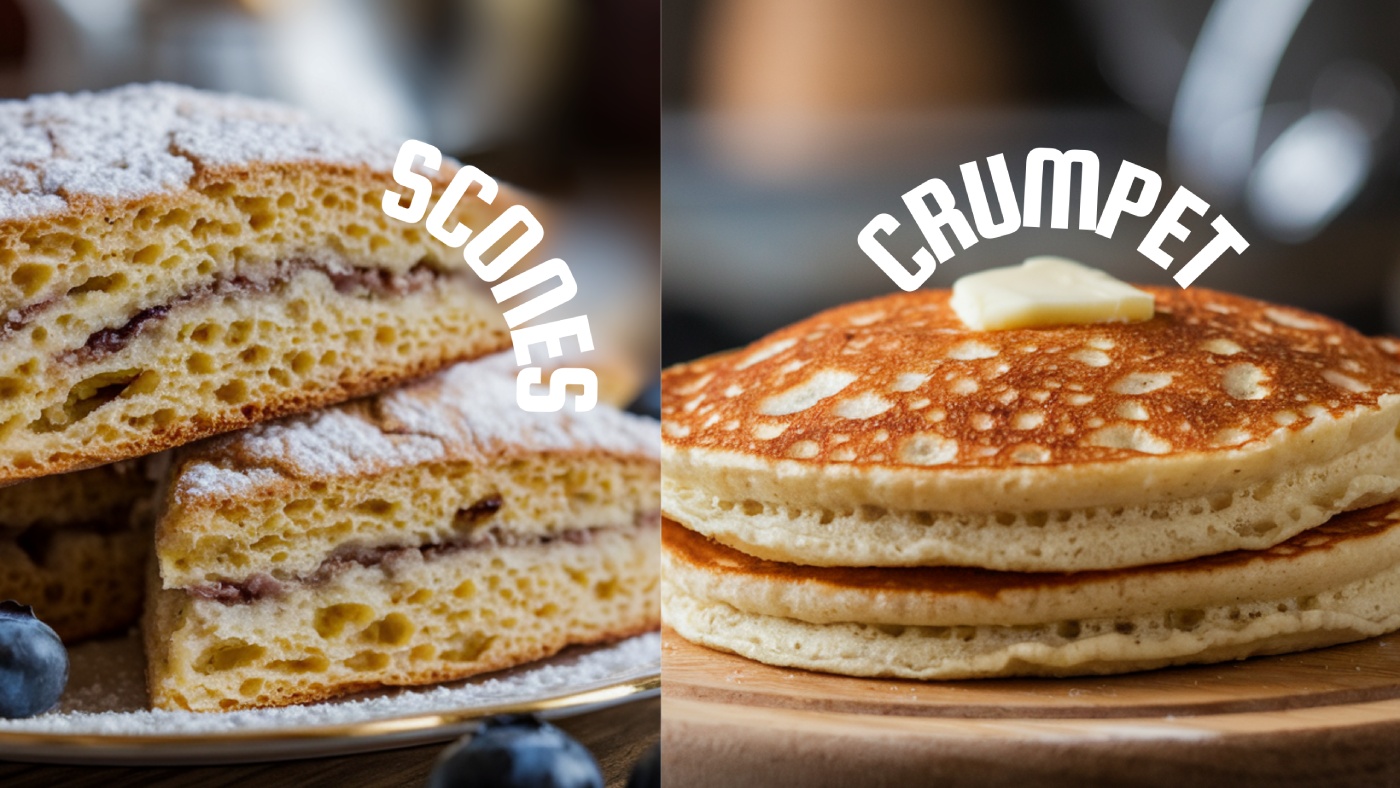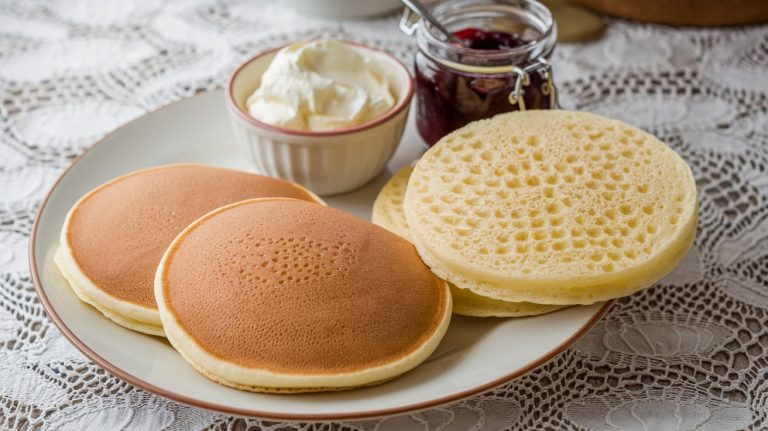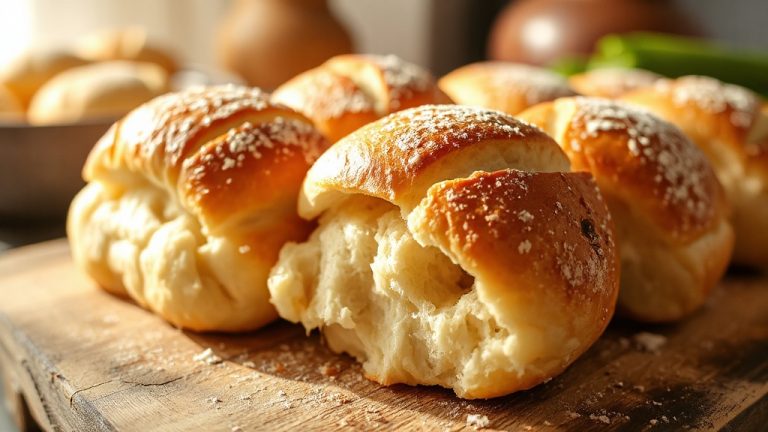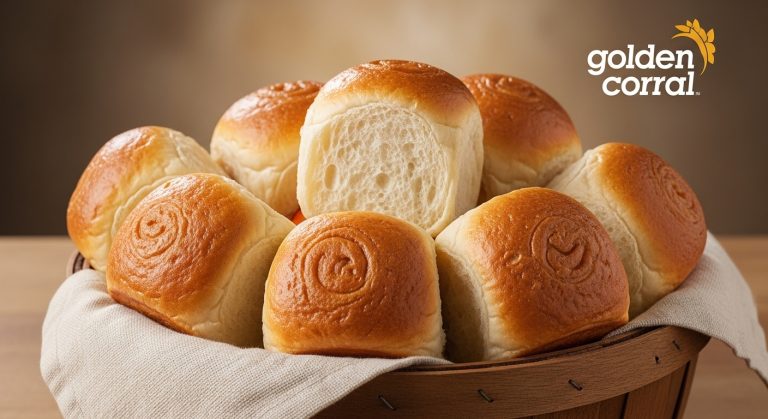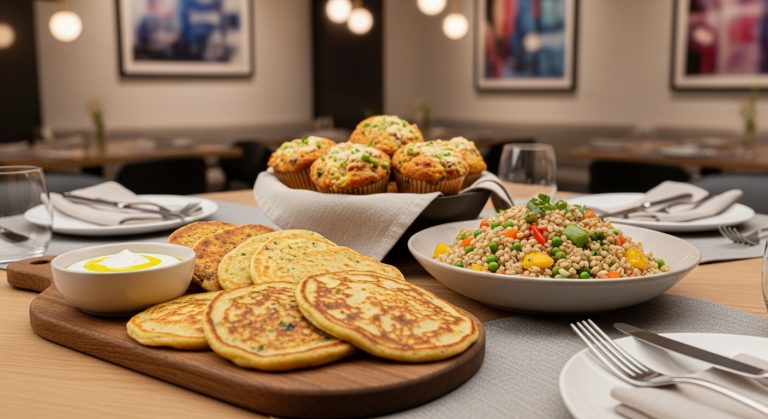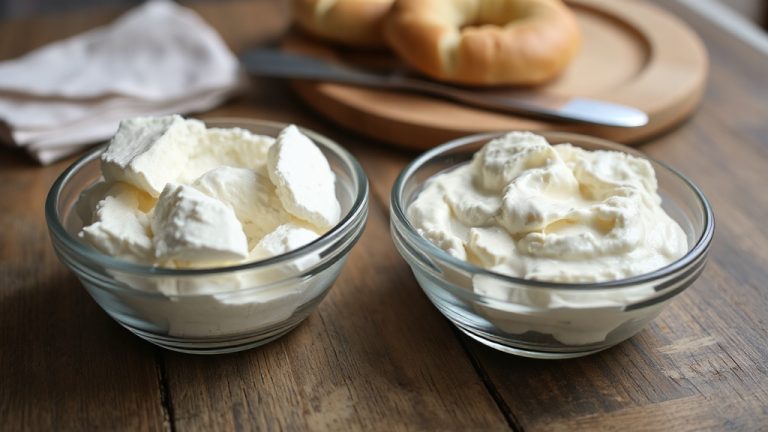Scones Vs Crumpets: Flavorful Favorites for Every Tea Time
When you think of scones versus crumpets, you’re exploring two icons of British tea culture. Scones are crumbly quick breads, rich and slightly sweet, often paired with clotted cream and jam.
They’re delightful fresh from the oven. Crumpets, on the other hand, are spongy, yeast-raised treats with tiny holes that soak up butter and toppings like a dream.
Both bring their unique textures and flavors to the table, making them perfect for tea time. Whether you prefer the rich, buttery scone or the airy, toasted crumpet, there’s more to discover about their intriguing differences and serving traditions.
Key Takeaways
- Scones are crumbly, quick bread made with flour, sugar, and butter, while crumpets are spongy, yeast-raised bread with a unique porous texture.
- Scones can be sweet or savory and are often served with clotted cream and jam, while crumpets are typically toasted and topped with butter or spreads.
- The preparation of scones involves cutting in cold butter, while crumpets require a fermentation process with yeast for their signature holes.
- Scones originated from Scotland and evolved into a staple of British afternoon tea, whereas crumpets were developed in the Victorian era from buckwheat cakes.
- Temperature affects enjoyment: warm scones are soft and aromatic, while toasted crumpets enhance their crispy exterior and moist interior.
What Are Scones?
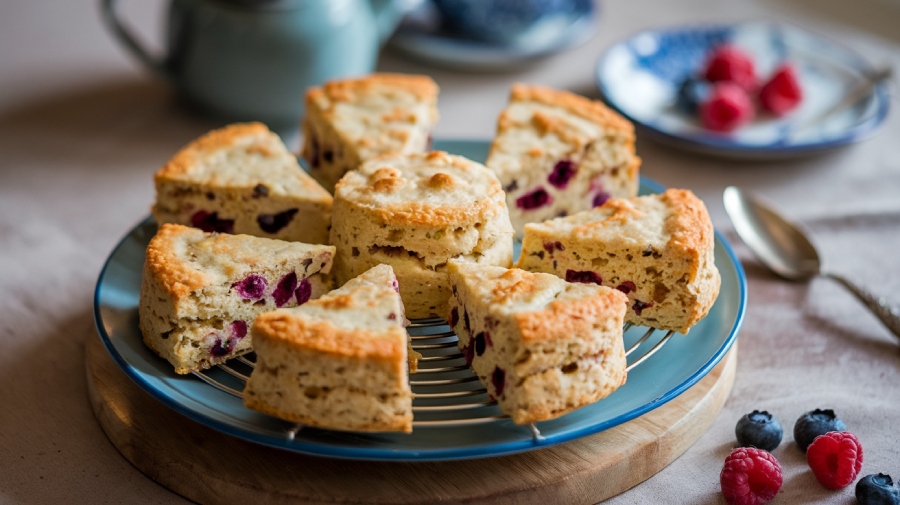
Scones, those delightful quick breads of British origin, have captured the hearts and taste buds of many around the world. Made primarily from flour, baking powder, butter, sugar, and milk, scones offer a wonderfully crumbly texture that’s both tender and satisfying. Scone originated in Britain, and this rich history adds to their charm.
You can shape them into rounds, triangles, or even diamonds, making them visually appealing for any occasion. Whether you enjoy them plain or with rich add-ins like currants or clotted cream, scones are often a staple at tea time.
British scones are lightly sweetened, while American versions tend to be sweeter and packed with mix-ins.
What Are Crumpets?
While scones may steal the spotlight at afternoon tea, crumpets offer a unique culinary experience that’s equally delightful.
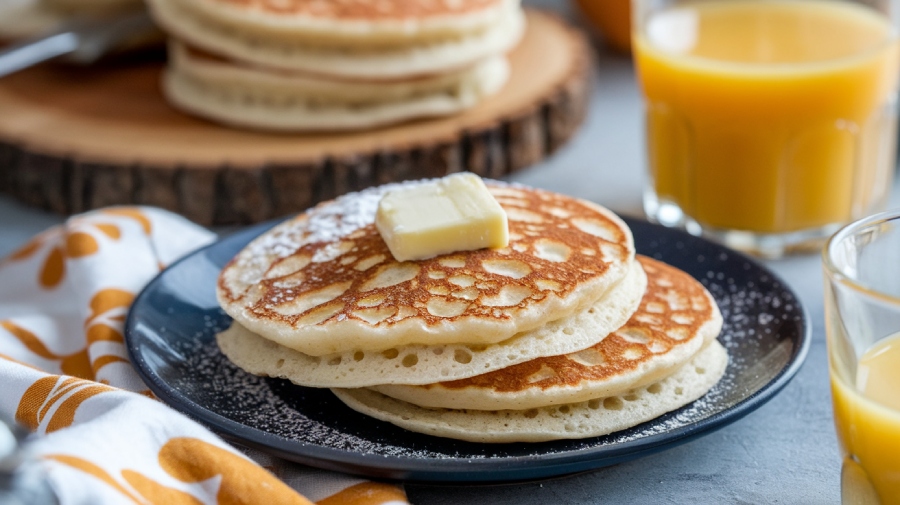
These small, round breads, raised by yeast, boast a spongy texture and a signature brown bottom. Originating in the UK, crumpets are baked on a griddle and often served toasted, making them perfect for slathering with butter or jam.
The magic lies in their many tiny holes, which soak up toppings beautifully. Historically traced back to 1382, crumpets have evolved but remain a staple in British culture, with their earliest recipe published by Elizabeth Raffald in 1769.
Key Ingredient Differences
When it comes to baking, the key ingredients differentiate scones and crumpets, each creating their own unique experience.
Scones rely on rich, flaky elements while crumpets focus on a soft texture with holes. Here’s a quick comparison of their key ingredients:
- Scones: All-purpose flour, granulated sugar, cold unsalted butter, buttermilk or heavy cream, and eggs.
- Crumpets: All-purpose flour, yeast, water, milk, and baking powder.
The presence of butter and sugar in scones gives them a tender crumb and sweetness.
In contrast, crumpets use yeast to develop their signature holes, resulting in a crispy exterior and soft interior. Additionally, crumpets are often enjoyed with various spreads to enhance their flavor profile.
Preparation Techniques
Baking scones and crumpets may seem simple, but the preparation techniques set them apart and influence the final texture and flavor.
For scones, you mix dry and wet ingredients separately, cutting in grated frozen butter for a crumbly texture. You combine everything gently to form a rough ball, then pat the dough into a square, cutting it into shapes without pressing too hard.
In contrast, crumpets require a thick batter made from flour, yeast, and milk, left to rise for fermentation. You ladle the batter into circular moulds on a hot griddle, cooking until bubbles form.
Each method shapes the final product, making scones flaky and crumpets soft with those signature holes.
Historical Origins
Scones and crumpets each boast rich historical origins that reflect their unique journeys through time.
- Scones likely derive from the Scottish Gaelic word “sgonn,” meaning a shapeless mass.
- Early crumpets, known as “crompid cakes,” appeared as flat pancakes made from buckwheat flour.
- In the 19th century, both scones and crumpets became staples of British afternoon tea and breakfast.
- Scones evolved with influences from English cuisine, incorporating butter and eggs for a lighter texture.
- Crumpets gained their signature holes through the introduction of baking powder during the Victorian era. Afternoon tea became a fundamental part of British culture, further solidifying the popularity of both scones and crumpets.
Traditional Serving Methods
When it comes to serving scones, the elegant presentation of cream tea plays an essential role in creating the perfect experience. You’ll find that warm, freshly baked scones are best accompanied by clotted cream and jam, inviting you to break and savor each piece with care.
This tradition reflects the afternoon tea customs that developed in Britain, showcasing scones as a staple treat. In contrast, crumpets demand a different approach, toasted to perfection and ready to soak up a variety of toppings, each bite bursting with flavor.
Cream Tea Presentation
A delightful cream tea presentation sets the stage for an indulgent experience steeped in tradition. To create the perfect ambiance, focus on the essential elements that elevate your tea time.
- Serve tea in fine bone china teapots.
- Offer warm, freshly baked scones.
- Accompany with clotted cream and jam.
- Include a sugar bowl and creamer on the table.
- Use a tablecloth, napkins, and a three-piece tea set.
Setting the table properly enhances the experience, ensuring each guest has a small plate for their scone and a butter knife at hand. Additionally, consider offering traditional tea options such as black or herbal tea to complement the scones and clotted cream.
Toasting Techniques
Creating a memorable tea experience goes beyond just a beautiful presentation; it also hinges on the way you toast and serve your treats.
For scones, warming them gently before serving is key. Split each in half and lavishly spread clotted cream and strawberry jam, enjoying their soft, buttery texture. Serve them immediately for the best flavor.
In contrast, crumpets demand a golden brown toast. Use a griddle or frying pan to achieve that crispy exterior while keeping the interior soft.
As soon as they’re toasted, add a pat of butter, allowing it to melt and seep into those delightful holes. You can top crumpets with jam, honey, or Marmite, enhancing their unique flavor.
Flavor and Texture Comparison
When you bite into a scone, you’re greeted by its dense, rich flavor that can range from sweet to savory. In contrast, crumpets offer a spongy texture that’s perfect for soaking up butter and jam, making each bite a delightful experience.
While scones can be enjoyed warm or cold, crumpets shine best when toasted and served piping hot, enhancing their unique characteristics. This is largely due to their yeasty pancake nature, which contributes to their airy holes that hold toppings beautifully.
Scone Flavor Profile
Scones offer a delightful blend of texture and flavor, making them a versatile choice for any occasion. Their unique combination of crumbly, tender interiors and puffy heights allows for a delightful experience with each bite.
Here’s what you might enjoy about scone flavors:
- Versatile Flavors: Sweet options like chocolate chips or savory choices featuring cheese and herbs.
- Rich Butter Flavor: The butter not only adds richness but also enhances flakiness. Biscuits, which also use butter, differ in texture due to their higher fat content.
- Egg Structure: Eggs contribute to the light, moist texture while binding ingredients.
- Sweet and Savory Balance: Scones can satisfy any palate, from mildly sweet to savory delights.
- Flavor Pairings: Enjoy them with clotted cream and jam for a burst of flavor.
Crumpet Texture Characteristics
Crumpets boast a unique texture that sets them apart from other baked goods, inviting you to explore their delightful character.
With a characteristic flat top and numerous small pores, they present a spongy, airy feel. The combination of plain flour and bicarbonate of soda creates abundant bubbles, while yeast fermentation enhances their lightness. In addition, crumpets are considered a star of the pancake family, showcasing their cultural significance in British baking.
When cooked on a griddle, crumpets develop a crispy exterior that contrasts beautifully with their soft, moist interior.
Unlike the dense, crumbly nature of scones, crumpets’ porous structure allows for excellent spread absorption, making them perfect for butter and jam.
Serving Temperature Differences
Although both scones and crumpets shine when served warm, their ideal temperatures evoke distinct sensory experiences.
Warm scones, fresh from the oven, are soft, aromatic, and perfect for absorbing clotted cream and jam. In contrast, crumpets need toasting to elevate their unique porous texture, allowing toppings to seep into their holes. Scones should ideally have a puffy height and lightness that is best appreciated when served warm.
- Warm scones enhance flavor and texture.
- Cold scones may taste denser and less aromatic.
- Reheating scones restores their delightful softness.
- Crumpets are best enjoyed toasted for prime texture.
- Serving temperatures greatly influence your enjoyment of each..
Popular Variations and Toppings
When it comes to enjoying baked delights, the variations and toppings for scones are truly delightful. You can indulge in sweet options like mixed berry or chocolate chunk scones, bursting with flavor and perfect alongside a cup of tea. English scones typically resemble American biscuits, which can influence the choice of toppings.
For a savory twist, try fresh herb scones, infused with garlic and chopped herbs, or cheesy scones packed with grated parmesan. Top your sweet scones with clotted cream and strawberry jam for that classic pairing, or drizzle some tangy lemon curd for an extra zing.
If you’re feeling adventurous, savor your savory scones with goat cheese and tapenade, elevating your snack to gourmet status.
Frequently Asked Questions
Can Scones Be Made Without Eggs?
Absolutely, you can make scones without eggs!
You’ll mix self-raising flour with cold butter, sugar, and your choice of milk or cream. You can add flavors like lemon zest or blueberries for a delicious twist.
By rubbing the butter into the flour and avoiding overmixing, you’ll create a crumbly texture.
Bake them at 400°F for about 20-25 minutes, and you’ll have delightful scones ready to enjoy, no eggs needed!
Are Crumpets Gluten-Free Options Available?
Yes, there are gluten-free options for crumpets available!
You’ll find brands like Liberate and Genius offering delicious gluten-free varieties.
If you prefer homemade, you can whip up your own using gluten-free self-raising flour and adjust the liquid for the right consistency.
Just remember, gluten-free flours absorb more liquid, so tweaking the recipe is essential.
With the right ingredients and techniques, you can enjoy a delightful crumpet experience without gluten!
How Long Do Scones Stay Fresh?
Scones stay fresh for about 2-3 days at room temperature, but you can extend their life by storing them in an airtight container.
If you refrigerate them, they’ll last 5-7 days.
Freezing is your best bet for long-term storage, keeping them good for 2-3 months.
When you’re ready to enjoy, you can bake frozen scones directly, just add a few extra minutes to the baking time for that perfect warmth!
Can Crumpets Be Frozen for Later Use?
Yes, you can freeze crumpets!
They’ll stay fresh for up to three months when stored in an airtight container. This is perfect if you want to enjoy that crispy outside and soft, spongy inside later.
Just remember to toast them on a low setting after taking them out, repeating the process two to three times for that ideal crunch.
Proper storage minimizes staleness, so you can enjoy them at their best!
What Beverages Pair Well With Scones or Crumpets?
When it comes to pairing beverages with scones or crumpets, you’ve got some delicious options.
For scones, consider a buttery Chardonnay or robust Earl Grey tea to enhance their flavors.
If you’re enjoying crumpets, traditional black tea works wonderfully, especially with toppings like jam or honey.
Don’t hesitate to experiment with fruity teas or rich wines, too; finding the perfect match can elevate your experience to a whole new level!
Scones and Crumpets: Partners in Deliciousness
In the delightful debate of scones versus crumpets, it’s clear that both have their unique charms. Scones, with their rich, crumbly texture, offer a comforting bite, while crumpets, soft and spongy, invite you to savor their warmth.
Whether you’re enjoying a scone with clotted cream or a crumpet dripping with butter, each brings its own flavor to the table. So, when it comes to tea time, you can’t go wrong—just remember, variety is the spice of life.

